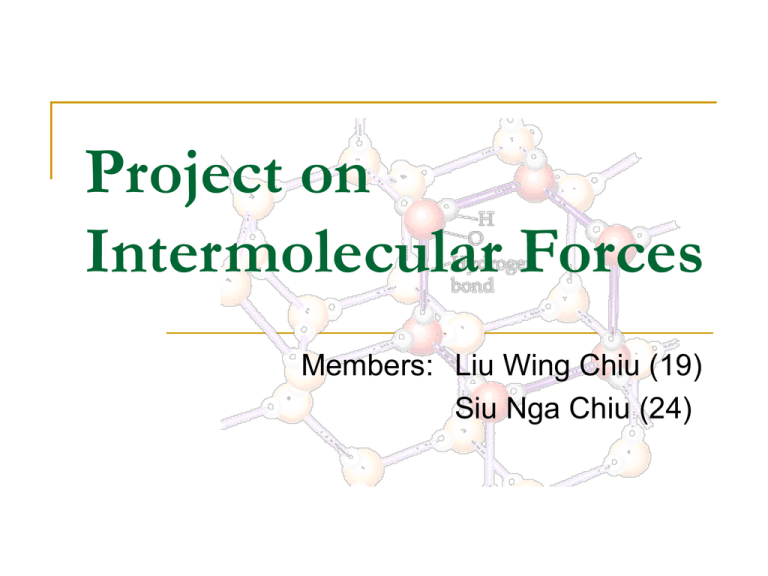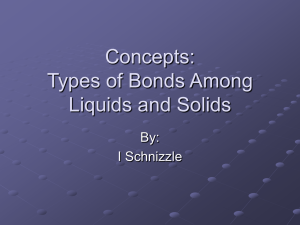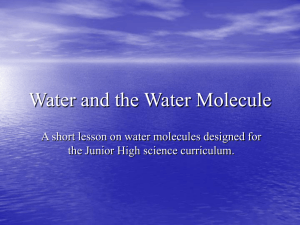The Origin of Intermolecular Forces
advertisement

Project on Intermolecular Forces Members: Liu Wing Chiu (19) Siu Nga Chiu (24) Intermolecular Forces The origin of intermolecular forces The classification of intermolecular forces Van der Waal’s force Hydrogen bonding Explore an example in depth to show the significance of existence of intermolecular forces. The Origin of Intermolecular Forces It is weak electrostatic force of attraction that exist an area of negative charge on one molecule and an area of positive charge on a second molecule. What causes intermolecular forces? Molecules are made up of charged particles: nuclei and electrons. When one molecule approaches another, there is a multitude of interactions between the particles in the two molecules. Each electron in one molecule is subject to forces from all the electrons and the nuclei in the other molecule. Intermolecular force is weak compared to covalent bond. It is relatively weak interactions that occur between molecules. There are 2 types of intermolecular forces (both of them are electrostatic attraction between dipoles formed by uncharged molecules.) 1. Van der Waals' force 2. Hydrogen bonding Van der waals’ force is formed by dipoles. There are 3 types of dipoles: 1. Permanent dipoles 2. Instantaneous dipoles 3. Induced dipoles Permanent Dipole These molecules have a permanent separation of positive and negative charge. A simple example is HCl + - The pair of electrons in the covalent bond between hydroge and chlorine is unequally shared due to the difference in electronegativity between hydrogen and chlorine. Chlorine has a greater electronegativity compared to hydrogen and hence Chlorine tends to attract the bonded electron pair to itself. chlorine becomes slightly negatively charged (-), hydroge atom has a partial positive charged (+) .The unsymmetrical distributed charge on the HCl molecule produces a permanent dipole. Instantaneous Dipole Instantaneous dipole is due to the fluctuation of electron clouds on non-polar molecules, positive and negative charges exist temporarily. Induced Dipole Induced dipole exist when a permanent dipole or instantaneous dipole comes close to a non-polar molecule, the non-polar molecule will be induced to form a dipole temporarily. The Classification of Intermolecular Force There are 2 major types of intermolecular force: Van der Waals’ force It can be divided into three categories: 1. Dipole-dipole Interactions 2. Instantaneous dipole-induced dipole Interactions 3. Dipole-induced dipole Interactions Hydrogen bond Classification diagram of intermolecular force Van der Waals’ Forces It is an attractive force which exist between all molecules. It is the weakest of intermolecular force. The force can be divided into three categories: 1 Dipole-dipole Interactions 2 Dipole-induced dipole Interactions 3 Instantaneous dipole-induced dipole Interactions Dipole-Dipole Interactions Dipole-dipole interactions exist between molecules which are permanent dipole. They tend to orientate themselves that the attractive forces between molecules are maximized while repulsive forces are minimized. In the illustration : the H end of HCl is permanently slightly positive charge. The Cl end of HCl has a permanent slight negative charge, the "H" in one molecule is attracted to the "Cl" in a neighbor. Instantaneous Dipole-Induced Dipole Interactions Also known as London forces or Dispersion Forces Instantaneous dipole-induced dipole Interactions exist in non-polar molecules. These forces result from temporary charge imbalances. The temporary charges exist because the electrons in a molecule or ion move randomly in the structure. The nucleus of one atom attracts electrons form the neighboring atom. At the same time, the electrons in one particle repel the electrons in the neighbor and create a short lived charge imbalance. These temporary charges in one molecule or atom attract opposite charges in nearby molecules or atoms. A local slight positive charge + in one molecule will be attracted to a temporary slight negative charge in a neighboring molecule. Note: dispersion forces operate in all molecules whether they are polar or non-polar. Dipole-Induced Dipole Interactions Also known as induction force. When a polar molecule approaches a nonpolar molecule, the permanent dipole on the polar molecule can distort the electron cloud of the nonpolar molecule, forming an induced dipole. Van der Waals Radius VS Covalent Radius Van der Waals radius is one half of the distance between the nuclei of two atoms in adjacent molecules. Covalent radius is one half of the distance between two atoms in the same molecules. Van der Waals’ radius of a nonmetal is always larger than the corresponding covalent radius because the covalent radius because covalent bond is much stronger than van der Waals’ forces. The Strength of the Van der Waals’ Forces The strength of the van der Waals' forces depends on size of electron cloud (how easily the electron cloud is distorted or polarized). For all molecules, the more number of electron (or weaker attraction force between nucleus and electrons), causing the higher in polarizability. The degree of uneven distribution of electron cloud is higher and the strengths induction force and dispersion force become stronger. Thus the stronger van der Waals’ forces. The strength of van der Waals' forces is also related to the surface area (or shape) of the molecule. For molecules with similar relative molecular masses or size, the higher contact surface area, the stronger van der Waals’ forces. Hydrogen Bonding Hydrogen bond is a electrostatic force of attraction existing between polar hydrogen(+) and electronegative atom(-) of dipoles. The hydrogen bond is weaker than the covalent bond, but relatively strong compared to van der Waals’ force. Hydrogen bonding is a unique type of intermolecular molecular attraction. There are two requirements. 1. The first is a covalent bond between a H atom and either F, O, or N (These are the three most electronegative elements.) 2. The second is an interaction of the H atom in this kind of polar bond with a lone pair of electrons on a nearby atom of F, O, or N. The presence of hydrogen bonding has an important effect on the properties of various substances: The melting and boiling points of the period two hydrides NH3, H2O and HF are much higher than are expected if only dipole-dipole forces were acting between the molecules. The solubility of molecular substances in water is greatly influenced by their ability to form H-bonds with water molecules. Water has several unusual properties which are related to H-bonding: High melting and boiling points given High surface tension. Expansion on freezing due to the formation of a regular ‘open-cage’ network of H-bonded water molecules. Liquids with hydrogen bonds between molecules usually have higher viscosity than comparable liquids that don't. H-bonding can influence acidity. H-bonded hydrogen atoms are often less likely to dissociate as H+ ions. H-bonding also plays important roles in: The folding of proteins. The structure of DNA. The manner in which hydrated crystals cleave. Hydrogen Bonding in Alcohols An alcohol is an organic molecule containing an -O-H group. Any molecule which has a hydrogen atom attached directly to an oxygen or a nitrogen is capable of hydrogen bonding. Such molecules will always have higher boiling points than similarly sized molecules which don't have an -OH or an -N-H group. The hydrogen bonding makes the molecules "stickier", and more heat is necessary to separate them. Ethanol, CH3CH2-O-H, and methoxymethane, CH3-O-CH3, both have the same molecular formula, C2H6O. Solubility If there are strong solute-solvent interactions, the solvent is soluble in the solute. Most ammonium, nitrate and sulphate salts are soluble in water since they form hydrogen bonds with water molecules. The high solubility of alkanols in water is cause by the formation of hydrogen bond. Carbohydrates have many –OH groups which can form hydrogen bond with water. Therefore carbohydrates with low relative molecular mass are soluble in water. Hydrogen Bonding in an Ice Crystal Ice has a lower density than water as ice has an open structure. In ice, each molecule is tetrahedral bonded to other molecules by hydrogen bond. Hydrogen Bond in Water Many other unique properties of water are due to the hydrogen bonds. For example, ice floats because hydrogen bonds hold water molecules further apart in a solid than in a liquid, where there is one less hydrogen bond per molecule. The unique physical properties, including a high heat of vaporization, strong surface tension, high specific heat, and nearly universal solvent properties of water are also due to hydrogen bonding. Hydrogen Bonding in DNA Hydrogen bonds play an important role in the ‘basepairing’ duplication of DNA (A-T,C-G). Matching of the bases produces an accurate duplicate of the original DNA chain. Boiling Points of Some Hydrides The figure shows the normal boiling point temperatures for several related substances. This boiling point diagram tells us about the intermolecular forces between a homologous series of small hydrogen containing molecules. Although for the most part the trend is that the boiling points increase as going down the group. The boiling point other hydride of the first element in each group is abnormally high. In the cases of NH3, H2O and HF there are hydrogen bond attraction, requiring significantly more heat energy to break. Explore an example in depth to show the significance of existence of intermolecular forces The Hardness of Calcium Sulfate (CaSO4) Gypsum (Hydrated CaSO4 , CaSO4·2H2O ) In the gypsum crystal structure, calciums are coordinated by six oxygens from sulphate, and by two oxygens from water (H2O). Two sheets of sulphates are bound together by calciums forming double sheet layers. At each side of these layers are water molecules, which form weak hydrogen bonds to the next layer in the structure. It is sectile and slightly flexible Anhydrite (Anhydrous CaSO4) Anhydrite has the same composition as Gypsum, but contains no water in its structure. There are only strong ionic bonds between ions. It is very hard and very difficult to cleave Calcined gypsum has an unusual property: when mixed with water at normal temperatures, it recombines with the water that was driven off during calcination, and sets to form a strong gypsum crystal lattice: CaSO4·½H2O + 1½H2O → CaSO4·2H2O This reaction is exothermic. The anhydrous form, called anhydrous calcium sulfate (sometimes anhydrite), is produced by further heating to above approximately 180°C (356°F) and has the chemical formula CaSO4. Anhydrite reacts slowly with water to return to the dihydrated state. Plaster of Paris (Calcium Sulfate Hemihydrate, CaSO4, ½ H2O) Plaster of Paris, or simply plaster, is a type of building material based on calcium sulfate hemi-hydrate, nominally (CaSO4)2. ½ H2O. It is created by heating gypsum to about 150°C. (CaSO4, 2 H2O) + heat = (CaSO4, ½ H2O) + 1.5 H2O When the dry plaster powder is mixed with water, it re-forms into gypsum, initially as a paste but eventually drying into a solid. The structure is made up of sheets of Ca2+ and SO42- ions held together by hydrogen bonds in the water molecules. The grip between these sheets is easily broken, so plaster is fairly soft. Its major use is in building, statuary, ceramics, dental plates, fine metal parts for precision instruments, and surgical splints. Use of Plaster of Paris Plaster is used as a building material similar to mortar or cement. Like those materials plaster starts as a dry powder that is mixed with water to form a paste, which then dries into a hard surface. Unlike those materials plaster remains quite soft after drying, and can be easily manipulated with metal tools or even sandpaper. Plaster was a common building material for wall surfaces in a process known as lath and plaster, in which a series of wooden strips were covered with a semi-dry plaster and then hardened into a flat surface. Today this building method has been almost completely replaced with drywall. Plaster expands while drying, then contracts slightly just before hardening completely. This makes plaster excellent for use in molds, and it is often used as an artistic material for casting. Plaster is also commonly spread over an armature (form), usually made of wire, mesh or other materials. In medicine, it is also widely used as a support for broken bones; a bandage impregnated with plaster is moistened and then wrapped around the damaged limb, setting into a close-fitting yet easily removed tube.








